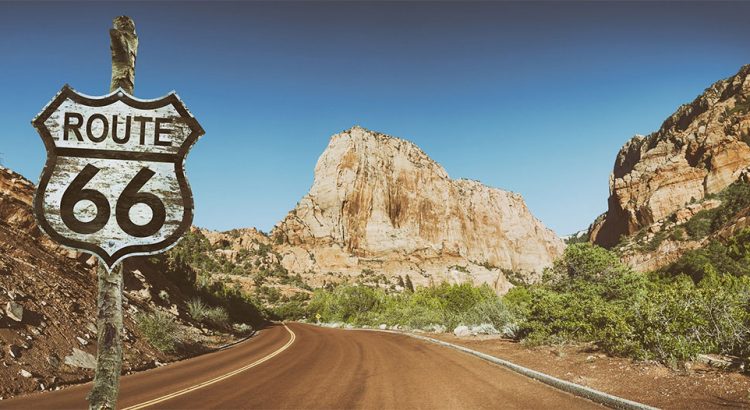Discover some of the most exciting journeys on Earth and be inspired to follow in the footsteps of the explorers who shaped the world as we know it!
Many of these epic historical and cultural routes have shaped the world as we know it. Whether you’re exploring the ghost towns of Route 66 or riding the highways from Russia to China on the Trans-Siberian Express, embark on one of the most exciting journeys in the world that will be the adventure of a lifetime.
1. Find out what happened to Route 66
In the history of the United States, no road symbolizes the American dream like Route 66. In the 1920s, entrepreneurs Cyrus Avery and John Woodruff conceived a highway that would connect America from east to west socially and economically. The highway will create opportunities for industry and business, as well as connect small rural and urban towns to the main road.
Route 66, also known as Mother Road and “America’s Main Street,” stretched 3,940 kilometers from Chicago to Los Angeles and passed through eight states and three different time zones. Although the 1950s was the best time for this famous route, when Americans bought cars and hit the road dreaming of adventure, the Interstate Highway Act was signed in 1956, beginning the decline of Highway 66 as others were built, more direct routes. By the mid-1980s, Route 66 was decommissioned, and even as local exits along the famous road began to disappear, the legend of the highway survived.
For decades, American novels, films, songs, and other popular culture have added to the legend of this historic highway. Portions of what remains of the Mother Road of America through Illinois, Missouri, New Mexico, and Arizona are designated Historic Route 66 National Scenic Lane, allowing it to be put back on some maps and lived on.
Today you can drive most of the original route and learn about what happened to it. Discover tiny towns, motels and landmarks scattered along the way, many frozen in time as if waiting for someone to wake them up again.
2. Discover the Modern Hippie Trail
Long ago, before conflict threw the Middle East and parts of South Asia into turmoil, the travelers who had such a profound impact on modern tourism traveled the region from west to east, trying to enlighten themselves, immerse themselves in the cultures, and swipe on some marijuana. and having a good time!
The hippie trail is a famous overland adventure from the mid-1950s to the 1970s, when energetic people used the cheapest modes of transport in Europe and Asia. They boarded buses and trains or hitchhiked from London or Amsterdam and traveled to places like Turkey, Iran, Afghanistan, Pakistan, Nepal and India.
During its heyday from the 1950s to the 1970s, important nodes along the hippie trail had hotels and restaurants crammed with visitors from other parts of the world who reveled in the travel lifestyle, spirituality, and good times. It was seen as an alternative form of tourism and allowed travelers to interact with locals rather than just sightseeing.
In the 1970s, political tensions and security concerns led to the route’s demise. It may not be possible today to walk the entire 5,500-kilometer hippie trail, but some parts of the route have been revived somewhat. There are several commercial trips across Europe and Asia, bypassing conflict zones. Many iconic places from the Hippie Trail still survive, such as Yener’s Café or Pudding Shop in Istanbul, Amir Kabir Hotel in Tehran and Freak Street in Kathmandu. Look for tours that connect England to other parts of Europe from where you can travel to Turkey, Iran, India, Pakistan and Nepal.
3. Drive along the Silk Road
To say that the Silk Road is woven into the fabric of our world would be an understatement, this complex network of highways and roads spanning at least 6,437 kilometers spans more than 40 countries. Its namesake comes from merchants who transported Chinese silk, along with other goods, along the seemingly innumerable roads that make up the Silk Road.
His role in the development of our world is immeasurable, in historical, social and cultural terms, the Silk Road is without a doubt one of the most incredible and interesting journeys that any modern explorer can take.
From one end of the Silk Road to the other, you’ll discover a world-long story: remnants of lost dynasties, ancient architecture, charming cities and natural wonders. The only way to take advantage of an offer as extraordinary as the Silk Road is through an overland adventure that takes you through the destinations of this vast network.
On the Silk Road, travelers can choose from several different paths,
depending on which parts of the world you are going to explore. To discover the Silk Road, book a course on Xi’an in China and choose to visit some of the following destinations: Uzbekistan, Tajikistan and Kyrgyzstan.
4. Backpack along the Gringo Trail
Distance along the Gringo Trail varies and, unlike the Hippie Trail, it is not considered an official route. However, when it comes to interesting trips with cultural diversity and scenic views, exploring almost all of Latin America (except Brazil), the Gringo Trail is the best choice. Most travelers focus on South America (Colombia, Ecuador, Peru, Bolivia, Argentina and Chile), Central America (El Salvador, Guatemala, Nicaragua, Costa Rica, Belize, Honduras and Panama) or Mexico.
To truly explore the Gringo Trail, fly into one of the many quirky towns and choose one destination and one mode of transport. Be aware that there is no land option between Mexico and Central America and South America.
5. Explore the Banana Pancake Trail
This is not really a route, but rather an idea. The Banana Pancake Trail is a cute nickname given to destinations in Asia where low-budget travelers and backpackers flock, resulting in a rise in regional tourism infrastructure (guest houses, restaurants that cater to Western tastes, bars, etc.). Although not an official route, the Banana Pancake Trail is a real life experience similar to the Gringo Trail or the Hippie Trail and includes a number of different trails that hikers take throughout Asia.
Some consider Thailand, Laos, Vietnam and Cambodia to be the main countries on this path. One of the most popular routes across South Asia starts in Bangkok, from where travelers travel to Ho Chi Minh City via Siem Reap and Angkor Wat. But other popular destinations such as Nepal (Pokhara, Everest base camp), India (Goa), Indonesia (Bali), Philippines, Myanmar and even parts of China are now considered part of the Banana Pancake Trail.
6. Travel on the Trans-Siberian Railway
Built between 1891 and 1916, the Trans-Siberian Railway is a colossal feat of engineering and vision. The Trans-Siberian Railway, which connects Moscow with the Russian Far East and branches to Mongolia, China and North Korea, is 9,289 kilometers long, making it the longest railway in the world.
On board, travelers will travel overland from Moscow to Vladivostok in Siberia and have the opportunity to explore the far reaches of Russia, as well as Mongolia and China. While an overland adventure can be completed in seven days, the best way to make the journey is to hop on and off at the many stops the train makes and stay to explore before heading to China.


